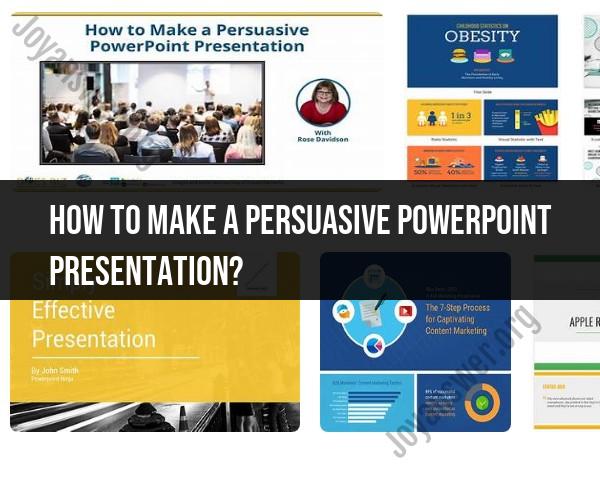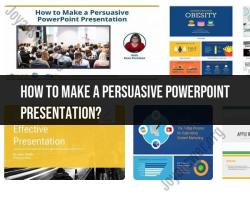How to make a persuasive PowerPoint presentation?
Creating a persuasive PowerPoint presentation involves more than just delivering information; it's about convincing and engaging your audience. Here are some steps and tips to make your PowerPoint presentation more persuasive:
Define Your Purpose and Audience:
- Clearly understand the objective of your presentation and who your audience is. Tailor your message and content to meet their needs and expectations.
Craft a Strong Opening:
- Begin with a compelling opening that grabs the audience's attention. You can use a startling fact, a thought-provoking question, a story, or a quote to pique their interest.
Use a Clear Structure:
- Organize your presentation with a logical structure. Common structures include problem-solution, cause-effect, or chronological order. Make sure your audience can easily follow your train of thought.
Limit Text:
- Avoid overcrowding slides with text. Use concise bullet points, keywords, and phrases rather than long paragraphs. The slides should serve as visual aids to support your spoken words.
Visuals and Graphics:
- Incorporate relevant visuals and graphics to enhance your points. Use high-quality images, charts, graphs, and diagrams to illustrate data and concepts. Visuals can make your message more engaging and memorable.
Tell a Story:
- Weave a narrative throughout your presentation. Stories resonate with people and help convey your message in a more relatable and emotional way.
Highlight Key Messages:
- Emphasize your key messages or takeaways. Use font size, color, and design elements to draw attention to critical information.
Use Persuasive Language:
- Choose your words carefully. Use persuasive language that appeals to logic (logos), emotions (pathos), and credibility (ethos). Address the audience's needs and concerns.
Cite Credible Sources:
- If you present data or facts, make sure to cite credible sources. This adds to your credibility and reinforces the validity of your arguments.
Engage the Audience:
- Encourage audience participation by asking questions, providing opportunities for discussion, or using interactive elements in your presentation.
Counter Arguments:
- Acknowledge and address potential counterarguments. Showing that you've considered opposing viewpoints and have a response can enhance your persuasive appeal.
Use Analogies and Metaphors:
- Analogies and metaphors can help simplify complex concepts and make them more relatable.
Consistency in Design:
- Maintain a consistent design throughout your presentation. Use a single, cohesive theme, color scheme, and font style for a professional and polished look.
Practice and Rehearse:
- Rehearse your presentation multiple times to become comfortable with the material. Familiarity with your content will make you more persuasive and confident when presenting.
Body Language and Voice:
- Your non-verbal communication, such as body language and tone of voice, plays a crucial role in persuading your audience. Maintain eye contact, use gestures effectively, and vary your voice tone for emphasis.
Q&A Preparation:
- Anticipate questions the audience might have and prepare thoughtful, well-reasoned responses.
Call to Action:
- End your presentation with a clear call to action. What do you want your audience to do or take away from your presentation? State it explicitly.
Feedback and Improvement:
- Seek feedback from colleagues or peers to refine your presentation. Constructive criticism can help you improve your persuasive approach.
Remember that the most persuasive presentations are those that connect with the audience on both a logical and emotional level. Engage your audience, address their concerns, and provide a clear path for them to follow, and your PowerPoint presentation is more likely to be effective and convincing.
How to create a persuasive PowerPoint presentation that engages your audience.
To create a persuasive PowerPoint presentation that engages your audience, follow these steps:
- Know your audience. What are their needs and interests? What do they already know about your topic? Tailor your presentation to their level of understanding and engagement.
- Have a clear message. What do you want your audience to know or do after seeing your presentation? Make sure your message is clear, concise, and persuasive.
- Use visuals effectively. Images, charts, and graphs can help to illustrate your points and make your presentation more engaging. Use visuals sparingly and strategically, and make sure they are high quality.
- Tell a story. People are more likely to be persuaded by stories than by facts alone. Use storytelling techniques to capture your audience's attention and make your presentation more memorable.
- Practice your delivery. Make sure you know your presentation inside and out so that you can deliver it confidently and smoothly. Practice in front of a mirror or with a friend or colleague.
Design principles and visual elements for an impactful PowerPoint presentation.
Here are some design principles and visual elements for an impactful PowerPoint presentation:
- Use a consistent design. Use the same fonts, colors, and layout throughout your presentation. This will create a sense of unity and professionalism.
- Use high-quality visuals. Use images, charts, and graphs that are clear, concise, and professional. Avoid using clip art or low-quality images.
- Use visuals sparingly. Don't overload your slides with text or visuals. Each slide should focus on a single main point.
- Use whitespace effectively. Whitespace is the empty space between text and visuals. Use whitespace to make your slides more readable and visually appealing.
- Use transitions and animations sparingly. Too many transitions and animations can be distracting and unprofessional. Use them sparingly to add emphasis to key points.
Strategies for crafting persuasive content and messages in your presentation.
Here are some strategies for crafting persuasive content and messages in your presentation:
- Use strong evidence. Back up your claims with strong evidence, such as data, statistics, and expert opinions.
- Use emotional appeals. People are more likely to be persuaded by messages that appeal to their emotions. Use stories, anecdotes, and personal experiences to connect with your audience on an emotional level.
- Use repetition. Repeat your key message throughout your presentation so that it sticks in your audience's mind.
- Use a call to action. Tell your audience what you want them to do after seeing your presentation. This could be anything from visiting your website to signing up for your newsletter to buying your product.
Techniques for effective delivery and communication during a PowerPoint presentation.
Here are some techniques for effective delivery and communication during a PowerPoint presentation:
- Be confident. Stand up straight, make eye contact, and speak clearly.
- Be enthusiastic. Show your audience that you are passionate about your topic.
- Be engaging. Use gestures, facial expressions, and vocal variety to keep your audience engaged.
- Use your voice effectively. Speak at a moderate pace and use pauses for emphasis.
- Interact with your audience. Ask questions, tell stories, and invite participation.
Real-world examples and case studies of persuasive PowerPoint presentations.
Here are a few real-world examples and case studies of persuasive PowerPoint presentations:
- Steve Jobs' iPhone presentation: In 2007, Steve Jobs introduced the iPhone in a presentation that is widely considered to be one of the most persuasive PowerPoint presentations ever given. Jobs used storytelling, humor, and visuals to create a sense of excitement and anticipation for the new product.
- Al Gore's climate change presentation: In 2006, Al Gore gave a presentation on climate change that used visuals and data to illustrate the dangers of climate change and the need for action. The presentation was widely praised for its clarity and effectiveness.
- Bill Gates' TED Talk on malaria: In 2009, Bill Gates gave a TED Talk on malaria that used a variety of visuals and props to explain the disease and its impact on the world. The talk was widely shared and helped to raise awareness of the issue of malaria.
These are just a few examples of persuasive PowerPoint presentations. By following the tips and strategies above, you can create your own persuasive presentations that will engage your audience and persuade them to take action.


